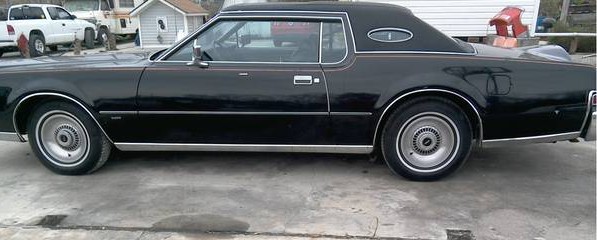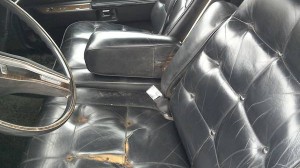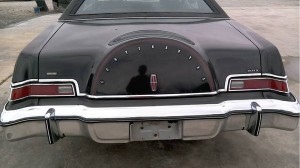The Cadillac Eldorado was king of the luxury coupe market in the sixties and early seventies. But it didn’t hold that top spot forever, and this car is the reason why. This 1975 Lincoln Mark IV appears here on craigslist in St. Louis, Missouri. This fine example looks great in black, and seems like a lot of car for the asking price of $3,000. The seller states it has 94,000 miles, and it looks to be in original and well cared for condition. I’ve always loved Cadillacs, but if I were in the market for one, now that I’m older and wiser I’d have to take a serious look at this car first. The Lincoln Mark IV surpassed the mighty Eldorado around this time frame, and that was a significant achievement considering the Mark wasn’t available in a convertible body style. There were 44,572 Eldorados produced in 1975, compared with more than 47,000 Mark IVs.
So how did it happen? Let’s compare. The Lincoln’s standard 460 cubic inch engine was smaller in displacement than Cadillac’s 500, but was actually rated with 33 more net horsepower. The Mark was heavier in curb weight, but boasted a faster quarter mile time, and a slightly higher top speed. The Mark was four inches longer than the Cadillac, but had a six inch shorter wheelbase. Four wheel disc brakes were standard for the first time, and that’s something none of the American muscle cars of the era had available, much less as standard equipment.
The Mark IV’s base price was higher this year, as many of last year’s options were now standard equipment; cruise control, tilt steering wheel, power door locks, remote control trunk lid release and more.
Lincoln offered two new luxury appearance packages, called “Lipstick and White”, and “Blue Diamond”, (although the car featured here is classic never-go-wrong black, with black leather interior). These packages were popular enough with Lincoln buyers that they were expanded in following years.
The term “malaise era” has been popular as of late. This car was made right in the thick of it. Although I doubt if I’d notice that if I were behind the wheel of this big, beautiful highway cruiser, in the lap of Lincoln luxury. This looks like a well-preserved unit. Another car that can be purchased for way less than its intrinsic worth. Dollars per pound, or however you want to figure it. For me, it would have a very short to-do list. I’d look in to having the seat repaired, make sure it’s maintained and mechanically good to go, charge up the A/C, and drive and enjoy. Do you love it as much as I do?





These look great in triple black.
I don’t get the “Mailaise era” thing. Sure the smog controls slowed cars down a bit, but how many classic car owners are riding their cars hard and doing burnouts? Most baby them and the high power is never used. This car could probably out drag 90% of the non muscle cars at a car show anyway.
I don’t get the “Mailaise era” thing. Sure the smog controls slowed cars down a bit, but how many classic car owners are riding their cars hard and doing burnouts? Most baby them and the high power is never used. This car could probably out drag 90% of the non muscle cars at a car show anyway. If I had a big storage building I would fill it with cars like this at $3000 because they won’t be cheap for long. Look at the pricing history of Lincolns and Caddy’s.
The “Malaise era” is not just about raw horsepower. It’s the technological and political dark ages that stretch from the early ’70s to the mid-1980’s.
Early smog equipment made engines hard to start, then they ran and idled poorly. They pinged, stumbled, and stalled on the newly mandated unleaded fuel, which had much lower octane than regular gas. Throttle response on a 1975-76 model car feels limp and soggy compared to its 1970-71 version. And it’s uglier too, thanks to gigantic federal 5-mph bumpers.
Added complexity under the hood made repairs more difficult to diagnose, with yards of vacuum lines that leaked and caused performance problems. Early catalytic converters got super hot. Datsuns and some other cars even had a dash warning light that said FLOOR TEMP, meaning the exhaust was so hot it might melt the carpet. Parking on grass could cause fires…it said so in the owner’s manual.
The simple mechanical carbureutor became very complex and difficult to tune, and some of the last carburetors supplied in the early 80’s before EFI could not be rebuilt and cost a whopping $1,000-1,500 to replace, which sent lots of otherwise serviceable cars to the junkyard.
In the bigger picture, GM began implementing extreme cost cutting, squandering their brand image, and their cars were plagued with recalls. Paint jobs peeled off and plastics crumbled in the sun. Chrysler nearly went under due to financial shenanigans and odometer-tampering scandals. UAW workers were surly and demanding while doing poor work and drinking on the job…this is how the notion of “don’t buy a car built on a Monday or Friday” came about. Dealerships had to refurbish or repaint brand new cars fresh off the truck. Foreign cars had trouble too. The new water-cooled VWs were unreliable and drank oil, French and Italian cars became a joke and largely disappeared from the scene, the Japanese had yet to perfect the engineering that let them dominate the 80s.
It took car companies about 15 years to successfully adapt to government requirements. Meantime, everyone who bought their products suffered through all the baby steps. Looking at nice examples that have survived, it’s hard to recall that cars were really, really shitty back then.
Almost forgot….Ford products of the Malaise era had big silver decals on the dashboard reminding drivers to use the parking brake, because their transmissions had a habit of slipping out of Park and the cars would roll away. Instead of a recall, they were ordered to supply customers with this sticker. This Lincoln likely has one of them on its dash.
Assuming that it runs and drives good that 3000 dollar price is more than fair. Someone will snap that up quickly.
Excuse me, but you are wrong when you said that by 1975 none of the american muscle cars had 4 wheel disc brakes as standard equipment. The Chevrolet Corvette (you may consider it a “sports car” . Had standard 4 wheel disc brakes on it since 1963
Just a heads up. Corvettes had four wheel disc brakes as standard equipment since 1967 I believe. And I for one do consider them muscle cars. Man, I think this car is a steal at that price! Nice rig!
Corvette had 4-wheel disc brakes standard starting in 1965.
1965 is an important year for Corvette. A long desired and needed upgrade – disc brakes – became standard equipment. The good news is that they appeared on all four corners, not just the front as was common practice of the day. Racers were particularly happy with this latest development as they had long been suffering with drum brakes. Although special sintered metallic linings had been available, fade under racing conditions was still a problem. Jaguar had been offering four wheel disc brakes on their more expensive E-Type and it wouldn’t do for the Corvette to be playing second in any area. The unloved drum brakes were still available as a deletion credit (RPO J61, -$64.50) and 316 1965 Corvettes were so equipped.
Hope you didn’t bet the keys to your Boss 429 ‘Stang on that last bit of trivia. The fact is, Chrysler was the first domestic automaker to offer four-wheel discs, and the year was 1949—two full years before the arrival of its Firepower Hemi engine, a time when all Chrysler engines were lethargic inline, flathead sixes and eights.
Though a $400 option on all ’49–’54 Chrysler automobiles
This car makes me think of William Conrad and the way he used to race around L.A. in the various Mark IVs he drove season after season playing the Frank Cannon character in the old Quinn Martin produced Cannon TV series. Looks like he sat in the front seat in this one way too long! Anyhow, hard to believe that show was on over 40 years ago – I must be getting old!
The price is definitely right, I predict a flipper will snag it. I have always like the Mk series of luxury cars.
Cannon, I liked that show as well.
Beautiful land yacht
Only 3 grand ? Hagerty price guide shows a # 1 worth over $30,000.00 !
Back in the day, if you said “nice Mark” people knew exactly what car yuo were talking about. This one is a great find at a good price. But my garage isn’t big enough. Alwys liked the opera windows.
I had a maroon one a few years back, a 76. Triple red. Loved that car. Nice find.
Rubbish carbs – rubbish interior trim – leaking rear axels – efficient when running right – always some for sale with super low mileage – last of the real cars
Wasn’t the name for the early hemi’s the “Fire Dome”? Really can’t remember..
Anyway, this Mark IV is a honey.. Not so sweet on gas mileage, but what “yacht” really is?
Just needs a seat repair and it’s almost perfect..
FirePower – Chrysler’s first V8 and first hemi engine, introduced in 1951 for Chrysler and Imperial. DeSoto and Dodge each received their own, unique smaller hemi line of engines in 1952 and 1953, called the FireDome and Red Ram,respectively . These engines, taken together, are now referred to as “1G” (1st generation) hemis, all have rear-mounted distributors.
Polyspheric – A polyspheric design introduced in 1955, derived from the FirePower for Plymouth.
Small block V8[edit]
Is this car open for bids? If so, where? Or, is this only for sale @ $3,000?
there is a link to the ad for this car in the first paragraph in red where it says “here on craigslist’
I doubt this will last long. Sure looks likes somebody will get a nice deal at $3,000. These really like to soak up the miles and drink up the fuel.
Hi North Americans ! I am a Frenchy (of France)… At home, we like your big old yatchland ! (though the streets of our cities are not suitable) . These are really exotic car for us ! We renovate it with passion ! My Mark IV pict at the arrival time in Europe in 2011 (1975 model : aqua blue luxury group…) ;-)
Le Baron,
That is one sweet ride!
Yes…it’s a sweet ride…460 ci engine (220 HP net). With leather interior aqua blue (luxury group in 1975). Exterior paint : “aqua blue diamond fire metallic” (Ford code 45)
soooo long, such a sweet body, all the toys, as Bachman Turner eloquently sings ROLL ON DOWN THE HIGHWAY!